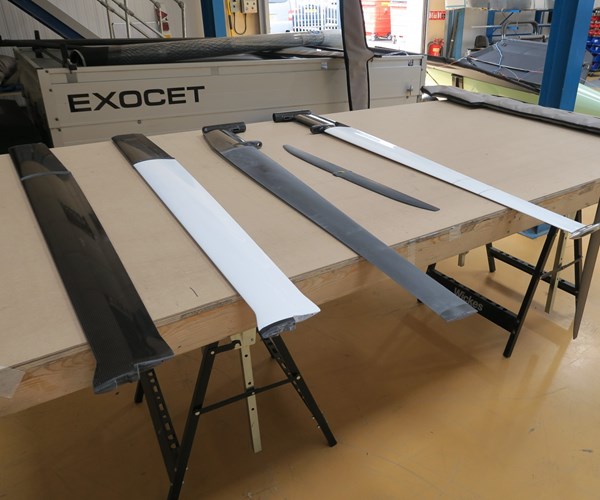This foiling racer is crazy fast thanks to composites
The Exocet racer’s hull and its foils, designed via computer model, are fabricated using hand layup and resin infusion methods, respectively, with PRO-SET epoxy.
I found in my inbox last week a picture like this one illustrating a blog by Jake Kavanagh (May 24, 2018) in the Epoxycraft newsletter —Epoxycraft is published by West System International (Romsey, UK), the maker of well-known marine epoxies WEST SYSTEM and PRO-SET under license from Gougeon Brothers Inc., now known as West System Inc. (Bay City, MI, US). The blog described the Exocet racer (Moth class) built by Maguire Boats (New Milton, Hampshire, UK) and it spurred me to do some research on how it is possible to do what the guy in the picture is doing.
First, what is a Moth? It refers to a class of small single-handed dinghys that first appeared in Australia in the late 1920s and in the US in 1930. The name “Moth” was coined by the American group, and Moth Class racing began later in the 1930s. An International Moth Class boat is 3.4m in length with unrestricted hull weight. So why is this small boat 6 feet above the surface of the water? It is, of course, supported by foils, or small wing-shaped structures at the ends of long tubular supports that attach to the hull. The foils create lift as the boat speed increases and lift the hull out of the water; the wetted area of the craft is radically reduced and boat speed is significantly increased.
Moths have been foiling since the 1970s, according to the International Moth Class Assn. UK web site — and did you know that foils were first invented by Alexander Graham Bell, working with Italian inventor Enrico Forlanini in the early 1900s? (Epoxycraft’s September 30, 2016 blog explains the history of foil development). In fact, according to some sources, the fast speeds achieved by foiling Moths was the inspiration for the most recent America’s Cup Class hydrofoiling yachts.
So the concept is more than 100 years old, but the technology for achieving 30 knots (55 km/hour) as described in Kavanagh’s blog is exemplified by Maguire Boats. The company, says the blog, has worked closely with designer Kevin Ellway for over five years since the introduction of the Exocet. This close partnership has enabled Maguire to continually improve a boat that has won the last three Moth World Championships as well as multiple European and National titles, including the 17 top positions at the Moth Worlds in Bermuda, earlier this year.

Foils for the Exocet are made in an infusion process using PRO-SET epoxy and ultra high modulus carbon cloth.
Kavanagh’s blog says that the Exocet hull and its foils, designed via computer model, are fabricated using hand layup and resin infusion methods, respectively, with PRO-SET epoxy. Maguire Boats’ managing director Simon Maguire says that his team first visited West System’s research lab to learn about effective infusion processes, ones that have resulted in parts with very high strength-to-weight ratio. For example, the hull components are a sandwich of ultra-high modulus (UHM) carbon fiber skins over a very thin foam core. With PRO-SET LAM 125 epoxy resin with LAM 226 hardener, the resulting hull section weighs just 10kg, says Maguire. The foils are infused in solid aluminum molds using PRO-SET infusion epoxy INF 114/210/211 with UHM carbon cloth, says the blog.
Maguire’s production rate is 24 boats a year, built in batches of four, according to Kavanagh’s blog. Maguire says “If we start making more than that, there is a risk to the quality. We pride ourselves on the consistency of the finish and performance of each boat, which makes them so sought after. Quality is everything – and as the results show, it wins races.” Read the entire Kavanagh blog here: https://www.epoxycraft.com/pro-set-laminated-maguire-exocets-top-moth-world-championships/ and learn more about the history of foiling watercraft here: https://www.epoxycraft.com/why-hydrofoiling-is-taking-the-sailing-world-by-storm/.
Related Content
Cryo-compressed hydrogen, the best solution for storage and refueling stations?
Cryomotive’s CRYOGAS solution claims the highest storage density, lowest refueling cost and widest operating range without H2 losses while using one-fifth the carbon fiber required in compressed gas tanks.
Read MoreInfinite Composites: Type V tanks for space, hydrogen, automotive and more
After a decade of proving its linerless, weight-saving composite tanks with NASA and more than 30 aerospace companies, this CryoSphere pioneer is scaling for growth in commercial space and sustainable transportation on Earth.
Read MorePlant tour: Joby Aviation, Marina, Calif., U.S.
As the advanced air mobility market begins to take shape, market leader Joby Aviation works to industrialize composites manufacturing for its first-generation, composites-intensive, all-electric air taxi.
Read MoreTU Munich develops cuboidal conformable tanks using carbon fiber composites for increased hydrogen storage
Flat tank enabling standard platform for BEV and FCEV uses thermoplastic and thermoset composites, overwrapped skeleton design in pursuit of 25% more H2 storage.
Read MoreRead Next
VIDEO: High-volume processing for fiberglass components
Cannon Ergos, a company specializing in high-ton presses and equipment for composites fabrication and plastics processing, displayed automotive and industrial components at CAMX 2024.
Read More“Structured air” TPS safeguards composite structures
Powered by an 85% air/15% pure polyimide aerogel, Blueshift’s novel material system protects structures during transient thermal events from -200°C to beyond 2400°C for rockets, battery boxes and more.
Read MoreDeveloping bonded composite repair for ships, offshore units
Bureau Veritas and industry partners issue guidelines and pave the way for certification via StrengthBond Offshore project.
Read More






















